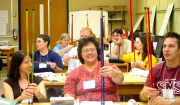Changing Science Curriculum Promotes Physics
MU Physics program receives $5 million grant to train physics teachers
October 7th, 2009

Ninth-grade science teachers participate in a teacher development program that will enhance their knowledge and abilities to teach physics.
COLUMBIA, Mo. – Traditionally, high school students take biology and chemistry before they take physics. However, only about 30 percent of students take physics in high school, according to the American Institute of Physics. Now, University of Missouri physics professors hope to increase the number of Missouri high schools that offer physics courses through a program called the Academy for Teachers using Inquiry and Modeling Experiences for Freshman Physics in Missouri (A TIME for Freshman Physics).
“College-level physics classes progress at a fast pace, and instructors expect a lot out of their students; this often comes as a major shock to students without a background in physics,” said Meera Chandrasekhar, director of the program and Curators’ Teaching Professor of Physics and Astronomy in the MU College of Arts and Science. “Coming into college with a good physics background will positively impact student success and the number of science and engineering majors our nation produces.”
A TIME for Freshman Physics recently received $5 million from the National Science Foundation. The program will partner MU faculty with school districts in Missouri, as well as other local colleges and organizations. Dorina Kosztin, MU professor of physics; Dorina Mitrea, MU professor of mathematics; Debi Hanuscin, education and physics professor; and Sara Torres of Columbia Public Schools are co-investigators in this project.
The grant funds a five-year teacher development program for 80 ninth-grade science teachers. It provides summer academies and year-round support to enhance their knowledge and abilities to teach physics and creates a group of intellectual leaders teaching physics who can improve other teachers’ understanding of physics and promote institutional change in the science curriculum. Teachers who are accepted into the program will be expected to adhere to requirements and use the curriculum in their classes. A week-long program also encourages math teachers to work alongside their physics counterparts, while also educating administrators about the benefits of teaching physics earlier in high school.
The order of science curriculum was suggested in 1892 by the Committee of Ten that was appointed by the National Education Association to standardize curriculum for American high schools. Richard H. Jesse, former president of MU and for whom Jesse Hall on the MU campus is named, was a member of the committee.
“Knowledge of science has changed dramatically since 1892,” Chandrasekhar said. “Biology has morphed from a descriptive science to a fairly technical, molecular study that combines elements of physics and chemistry. With the current understanding of science, it makes more sense to teach physics first.”
A TIME for Physics First ran a similar program with a prior grant with students graduating in 2010. While the students have yet to graduate high school, their teachers are reporting an increase in their science and math scores, Chandrasekhar said.
For more information about the program, visit www.physicsfirstmo.org.

